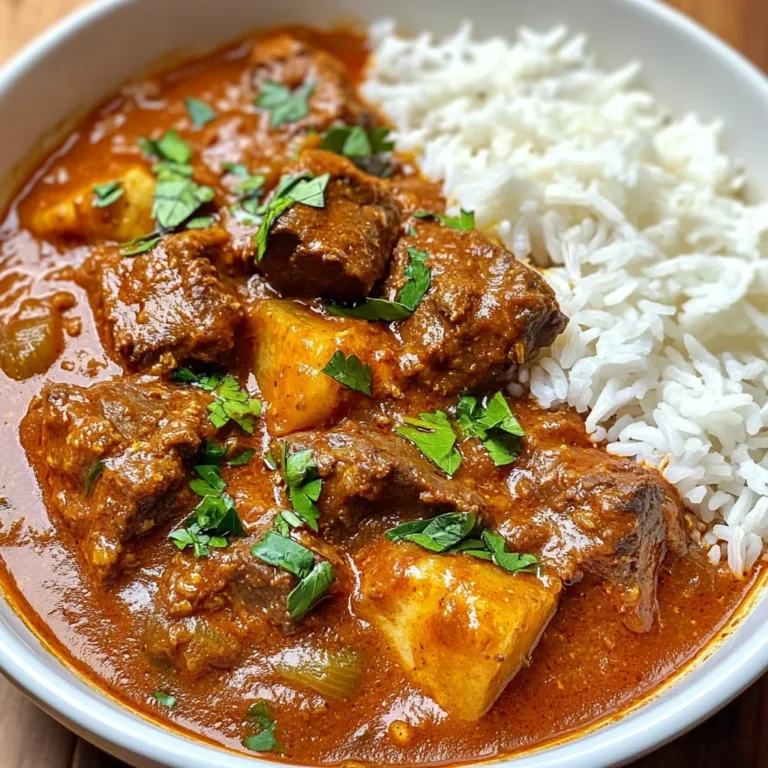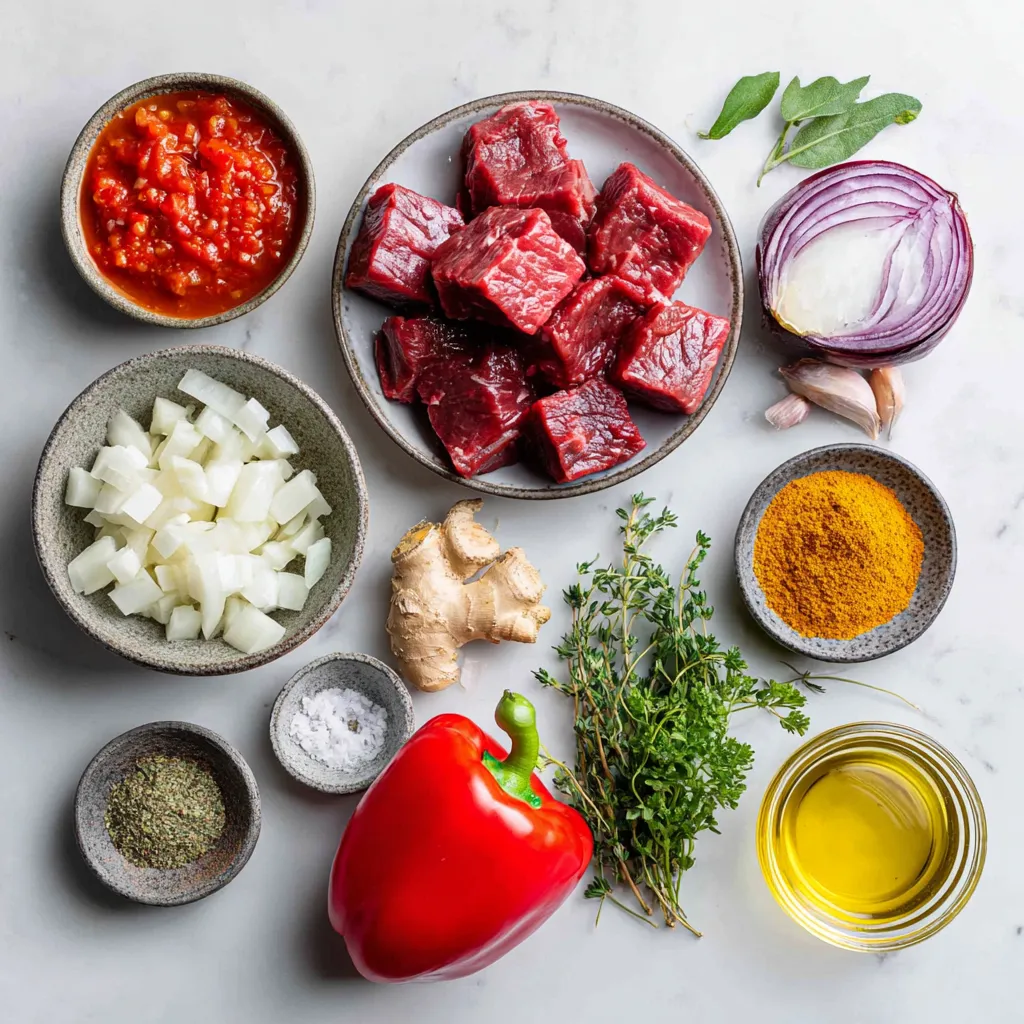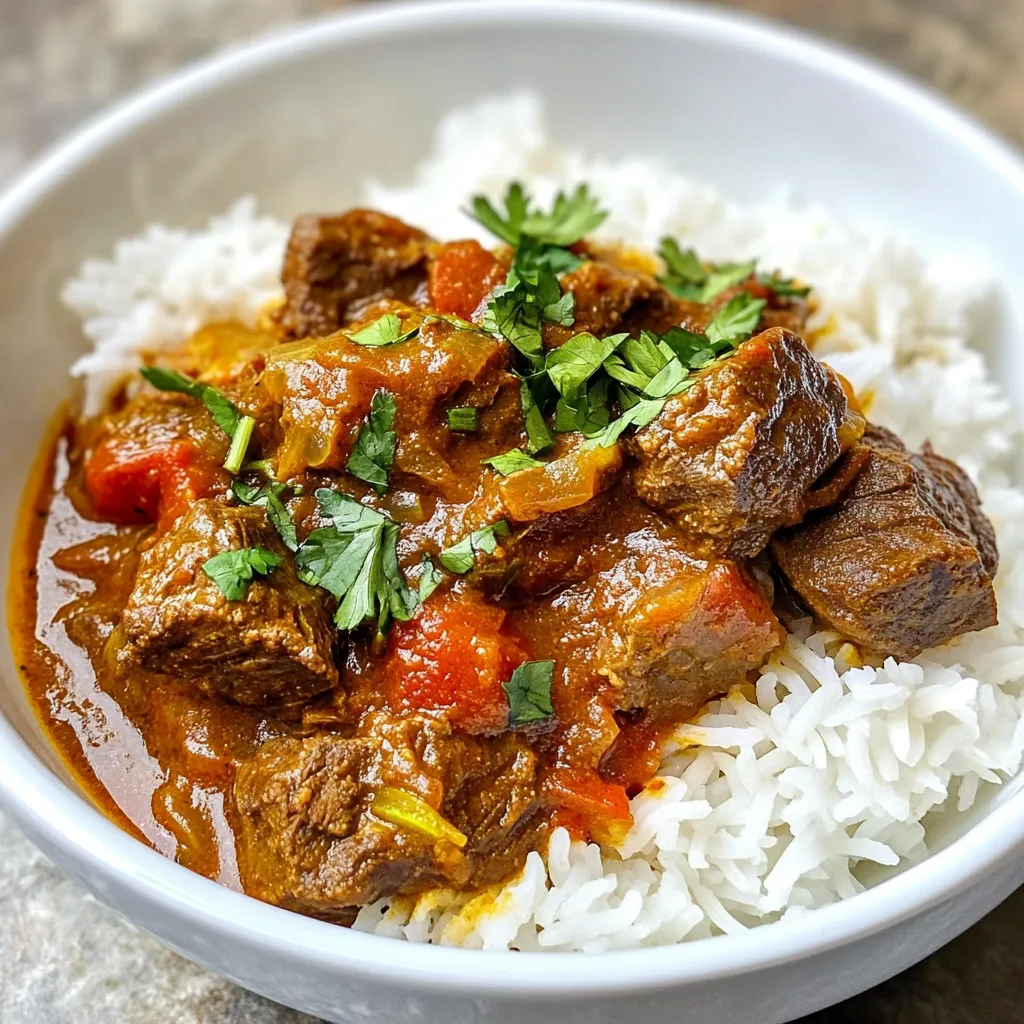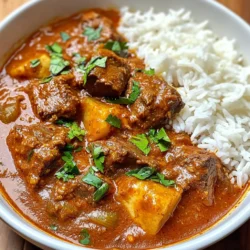WANT TO SAVE THIS RECIPE?
Are you ready to dive into a bowl of pure comfort? Nigerian Beef Stew is a flavorful, hearty dish that will warm your soul. With fresh ingredients and rich spices, this stew brings together vibrant tomatoes, savory beef, and aromatic peppers for a meal that sings with tradition. Let me show you how to create this delicious stew step-by-step. Trust me; your taste buds will thank you!
Why I Love This Recipe
- Rich Flavor: This stew is packed with a rich blend of spices and fresh ingredients, creating a savory experience in every bite.
- Comfort Food: Nigerian Beef Stew brings warmth and comfort, making it perfect for family gatherings or cozy nights in.
- Versatile Pairing: It pairs beautifully with rice, plantains, or even bread, making it a versatile dish suitable for any occasion.
- Easy to Prepare: With straightforward steps and accessible ingredients, this recipe is simple enough for cooks of all levels to enjoy.
Ingredients
List of ingredients
– 2 lbs beef, cut into cubes
– 4 large tomatoes, blended into a puree
– 1 onion, finely chopped
– 2 red bell peppers, blended
– 1 scotch bonnet pepper, blended
– 4 cloves garlic, minced
– 1 inch ginger, minced
– 1/4 cup vegetable oil
– 2 cups beef broth or water
– 1 teaspoon thyme
– 1 teaspoon curry powder
– 2 tablespoons ground crayfish (optional)
– Salt to taste
– Fresh parsley or cilantro for garnish
Importance of fresh ingredients
Using quality beef makes a big difference. Fresh meat gives rich flavor and tenderness. Choose ripe tomatoes and peppers for a bright taste. They add sweetness and depth. Fresh herbs enhance aroma and freshness. Don’t skip these; they make your stew shine.
Optional ingredients for enhanced flavor
You can try ground crayfish for a unique taste. It adds a subtle, seafood-like flavor. Some people use other spices, too. Experiment with smoked paprika or allspice. Each addition brings a new twist to your stew. Enjoy the process of discovering what you like!

Step-by-Step Instructions
Preparation of beef and vegetables
Start by cutting the beef into small cubes. This helps the meat cook evenly. Aim for about 1 to 2 inches in size. Next, chop the onion finely. This will add flavor to the stew. For the blended mixture, blend the tomatoes, red bell peppers, and scotch bonnet pepper until smooth. This mix forms the base of your stew.
Cooking process
In a large pot, heat the vegetable oil over medium heat. Once the oil is hot, add the chopped onions. Sauté until they look clear and soft. This takes about 3 to 4 minutes. Now, add the minced garlic and ginger. Cook for 2 more minutes to release their aroma. Then, pour in your blended mixture. Let it cook for 10 to 15 minutes. Stir often. You want the sauce to thicken and the oil to separate from the mix.
Simmering and enhancing flavors
After the sauce thickens, add the beef cubes. Stir to coat the meat well with the sauce. Cook for about 5 minutes. This helps the beef absorb flavors. Now, add thyme, curry powder, and salt. Stir everything together. Next, pour in the beef broth or water. Bring the pot to a boil. Once boiling, reduce the heat to low. Cover the pot and let it simmer for 1 to 1.5 hours. Stir occasionally to check. You can tell the beef is tender by poking it with a fork. If it breaks apart easily, it’s ready.
Tips & Tricks
Achieving authentic Nigerian flavors
Simmering is key to great flavor. When you simmer, you let the beef absorb all the tasty spices and sauce. This slow cooking helps the meat become tender. Aim for at least one hour of simmering to reach that rich taste.
The spice balance is also crucial. Use the right amount of thyme and curry powder. Too much can overpower the dish, while too little can make it bland. Taste as you go. Adjust the spices based on your preference.
Cooking techniques
Choose the right pot for cooking. A heavy pot helps keep the heat steady. This is important for even cooking. Cast iron or a thick-bottomed pot works best. Avoid thin pots that can burn the stew.
Control the temperature during cooking. Start on medium heat to sauté the onions and spices. Then reduce to low when you add the beef and broth. This helps the stew simmer gently without boiling too fast.
Common mistakes to avoid
Be careful not to overcook the vegetables. Add them at the right time to keep their color and crunch. If you add them too early, they can turn mushy.
Watch your seasoning too. A common mistake is not adding enough salt. Taste your stew before serving. You want to ensure it has that bold, flavorful kick. If needed, add a pinch more salt to enhance the taste.
Pro Tips
- Choose the Right Cut of Beef: Opt for cuts like chuck or brisket for a tender stew; they break down beautifully during the long cooking process.
- Enhance the Flavor: For a deeper flavor, allow the tomato sauce to cook longer until the oil separates, making it rich and aromatic.
- Adjusting Spice Levels: If you prefer a milder stew, remove the seeds from the scotch bonnet pepper before blending, or use less of it.
- Let it Rest: Allowing the stew to rest for about 30 minutes after cooking can enhance the flavors as they meld together.

Variations
Alternative proteins
You can swap beef for chicken. Chicken cooks faster and can soak up the rich flavors well. You will still get a hearty dish. For a different taste, try goat meat. Goat meat has a unique flavor that many enjoy. It works great with the same spices used in the beef stew.
Vegetarian options
If you want a meat-free stew, use plant-based protein substitutes. Options like tofu or tempeh can mimic the texture of beef. They absorb the spices and sauce nicely. You can also use mushrooms for a savory taste. Mushrooms add depth to the stew, making it rich and hearty without meat.
Regional variants
Different regions in Nigeria have their own twists on beef stew. Some use local spices that add unique flavors. For example, some might add locust beans for a distinct taste. Others may include local peppers or herbs. These ingredients give each stew its own character, making it fun to explore.
Storage Info
How to store leftover beef stew
To keep your beef stew fresh, store it in a tight container. Allow it to cool first. Then, place it in the fridge. It can last for about three to four days. If you want to save it longer, freezing is a great option.
– Refrigeration guidelines: Make sure the stew cools to room temperature. Use a glass or plastic container with a lid.
– Freezing tips: Portion the stew into freezer bags. Remove as much air as possible. Label each bag with the date.
Reheating instructions
Reheating your stew is easy. You want to keep the flavors and texture just right. The best method is to use the stove. You can also use a microwave, but the stove works better for flavor.
– Best methods for reheating: Heat the stew in a pot over low heat. Stir often to avoid sticking. If using a microwave, heat it in short bursts, stirring in between.
– Maintaining flavor and texture: Add a splash of beef broth or water if it seems too thick. This helps keep the stew juicy.
Shelf life
Knowing how long your stew lasts is key. In the fridge, it can last a few days. If frozen, it can last up to three months.
– Duration in the fridge: Eat refrigerated stew within four days for the best taste.
– Signs of spoilage: Look for off smells or changes in color. If it smells bad or looks strange, throw it away.
FAQs
What can I serve with Nigerian Beef Stew?
You can serve Nigerian Beef Stew with many tasty sides. Here are some great options:
– White rice: A fluffy base to soak up the stew.
– Fried plantains: Sweet and savory, they make a perfect match.
– Pounded yam: This smooth dish pairs well and adds heartiness.
– Nigerian jollof rice: A spicy, tomato-based rice dish complements the stew.
Traditional accompaniments include:
– Eba: A starchy side made from cassava flour.
– Fufu: A soft, dough-like food made from various starchy ingredients.
Can I make Nigerian Beef Stew in a slow cooker?
Yes, you can use a slow cooker for Nigerian Beef Stew. Here’s how:
1. Sauté onions, garlic, and ginger in a pan for flavor.
2. Add blended tomatoes and peppers, cooking for a few minutes.
3. Transfer everything to the slow cooker with beef, broth, and spices.
4. Cook on low for about 6-8 hours or high for 3-4 hours.
Benefits of slow cooking include:
– Enhanced flavors: Slow cooking melds spices and ingredients well.
– Tender meat: The beef becomes very soft and easy to eat.
– Convenience: You can set it and forget it, freeing up your time.
How can I adjust the spiciness of the stew?
You can easily change the heat level of your stew. Here are some tips:
– For less heat, use fewer scotch bonnet peppers or remove seeds.
– Add more tomatoes to dilute the spice.
– Mix in some sugar or honey to balance the heat.
Adjusting spice levels safely is key. Always taste as you go. This way, you can find the right level that suits your palate.
This blog explored essential ingredients and steps to create a delicious Nigerian beef stew. Fresh ingredients like quality beef and ripe tomatoes enhance taste. Accurate cooking techniques bring out the best flavors.
Remember to store leftovers properly to enjoy later. You can also try variations with different proteins or adjust spice levels to suit your taste. By following these tips, you’ll create a stew that’s packed with flavor and comfort. Enjoy your cooking journe
Nigerian Beef Stew
Discover the rich flavors of Nigerian beef stew with our easy beef stew recipe! This traditional Nigerian recipe is perfect for family dinners and brings the essence of Nigerian cuisine right to your table. Learn how to make Nigerian stew that will impress everyone. Grab your ingredients and start cooking this delicious dish today! Save this recipe for your next meal adventure! #NigerianBeefStew #BeefStewRecipe #NigerianCuisine #TraditionalNigerianRecipes
2 lbs beef, cut into cubes
4 large tomatoes, blended into a puree
1 onion, finely chopped
2 red bell peppers, blended
1 scotch bonnet pepper (adjust to taste), blended
4 cloves garlic, minced
1 inch ginger, minced
1/4 cup vegetable oil
2 cups beef broth or water
1 teaspoon thyme
1 teaspoon curry powder
2 tablespoons ground crayfish (optional)
Salt to taste
Fresh parsley or cilantro for garnish
In a large pot, heat the vegetable oil over medium heat. Once hot, add the chopped onions and sauté until translucent.
Add the minced garlic and ginger, cooking for an additional 2 minutes until fragrant.
Pour in the blended tomato, red bell pepper, and scotch bonnet mixture. Allow it to cook for about 10-15 minutes, stirring occasionally, until the sauce thickens and oil begins to separate from the mixture.
Add the beef cubes to the pot, stirring well to coat them in the sauce. Cook for about 5 minutes.
Season the mixture with thyme, curry powder, and salt.
Pour in the beef broth (or water) and bring the mixture to a boil. Reduce the heat to low, cover, and let it simmer for 1-1.5 hours until the beef is tender, stirring occasionally.
If using ground crayfish, stir it in during the last 10 minutes of cooking for added flavor.
Once done, taste and adjust seasoning if necessary.
Garnish with freshly chopped parsley or cilantro before serving.
Prep Time: 15 mins | Total Time: 1 hr 45 mins | Servings: 6
Presentation Tips: Serve the stew hot over a bed of fluffy white rice or with fried plantains on the side, accompanied by a sprinkle of fresh herbs for a vibrant touch.
WANT TO SAVE THIS RECIPE?





